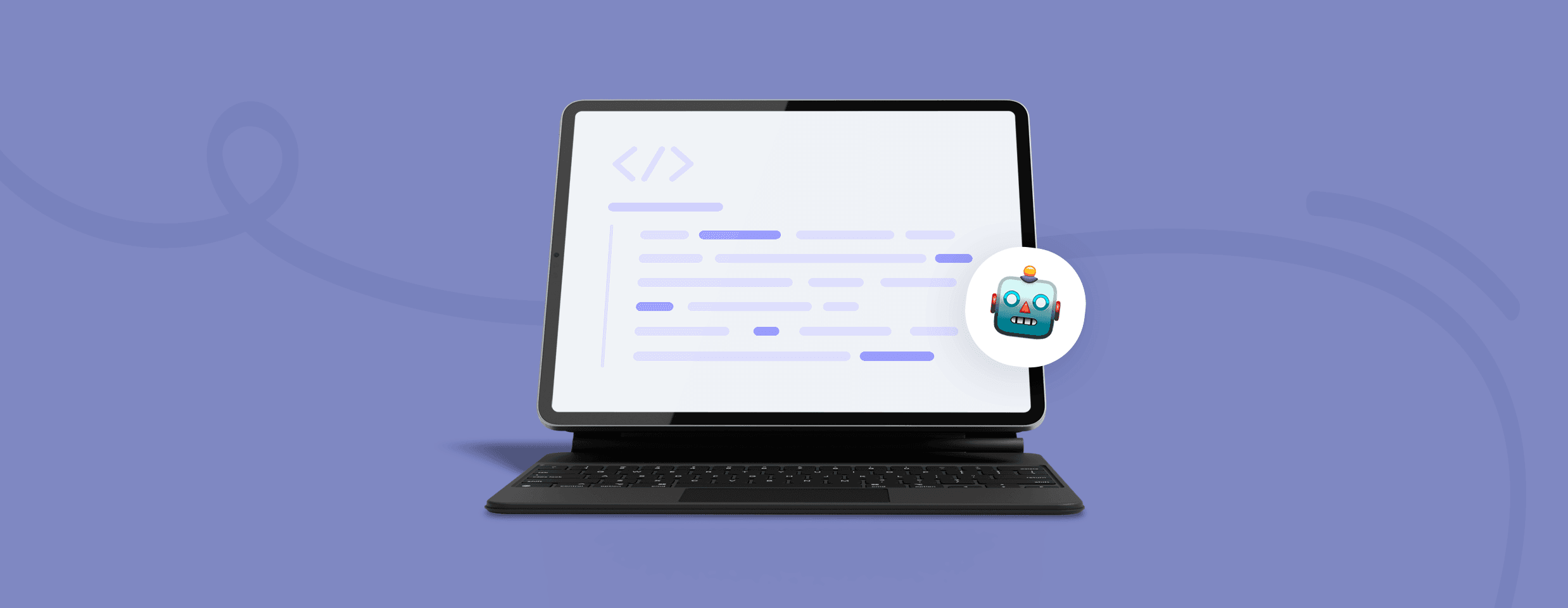So you want to develop your own chatbots.
But is coding it from scratch the most effective way to do it?
Let me guess.
You already thought about using a bot framework to make the process more efficient. It would be quicker and there’s a lot of people who can help you out in case of any issues.
But—
What are some of the best options to consider when it comes to open-source chatbot frameworks? And what are the essentials you should know about them?
Let’s find out the answers to these questions.
In this article:
- What chatbot frameworks are
- Why use them
- Reviews of the best open-source chatbot frameworks
- How to choose the best one for your business
Design custom chatbots in minutes without the need to code
If you want to find out more about chatbots, check out these articles:
- Chatbot Design: Best Practices & 12 Insider Tips [2022]
- 7 Amazing Chatbot UI Examples to Inspire Your Own
- Want a Chatbot to Succeed? Give It a Personality
From the beginning—
What is a chatbot framework?
A chatbot framework is a solution specifically created for developing bots and defining their behavior. It decreases the amount of manual work that is normally involved in building a chatbot.
A bot developing framework usually includes a bot builder SDK, bot connectors, bot directory, and developer portal. Once you develop your chatbot, there’s a console to help you test it.
Simply put, bot frameworks offer a set of tools that help developers create chatbots better and faster.
Chatbot frameworks come in a variety of different coding languages. For example, this conversational AI development environment for Amazon devices uses JavaScript in its framework:
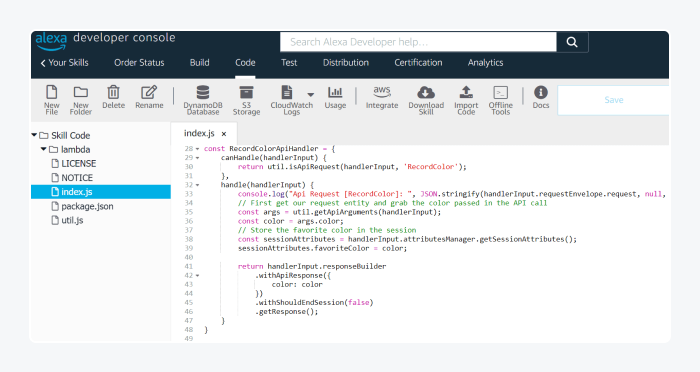
But—
Are bot frameworks the same as chatbot platforms?
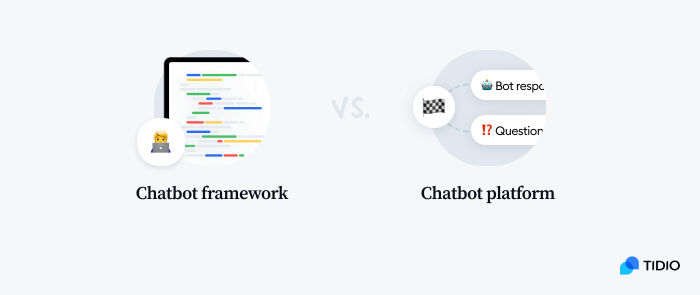
Sometimes the terms are used interchangeably, but they are not the same.
Chatbot platforms are usually ready-to-use solutions with visual builders. They are powered and hosted by third parties and require no coding skills. When it comes to chatbot frameworks, they give you more flexibility in developing your bots. However, frameworks require coding.
Think of it this way—the bot platform is the place where chatbots interact with users and perform different tasks on your behalf. A chatbot development framework is a set of coded functions and elements that developers can use to speed up the process of building bots.
They’re also used by different people. Usually, platforms are used by non-technical users to build chatbots without the need to code anything. In comparison, frameworks are mostly used by developers and coders to create chatbots from scratch with the use of programming languages.
What is an open-source chatbot?
An open-source chatbot is a software that has its original code available to everyone. Users can tweak this code depending on their needs and preferences. You can find these source codes on websites like GitHub and use them to build your own bots.
The main purpose of these chatbots is the same as for the platforms that aren’t open-source—to simulate a conversation between a user and the bot. The free availability of the code leads to more transparency, but can also provide higher efficiency by collecting developers’ contributions relating to any changes.
Some examples of open-source chatbots include:
- OpenDialog—develops rich conversational interfaces for your systems and business processes
- Botonic—a full-stack framework without a server that combines React and Tensorflow.js to improve user experiences of text and graphical interfaces
- Claudia Bot builder—extension library for Claudia.js with the focus on developing your business workflows on the bot
Okay.
But why should you use a chatbot framework in the first place? Let’s look at some advantages and disadvantages to weigh it out.
Why use a chatbot framework?
Before the abundance of supporting infrastructure and tools, only a few experienced developers were able to build chatbots for their clients. This service was difficult to perform and took a long time. Thankfully, nowadays, you can use a framework to have the groundwork done for you. This way, even beginner developers can create custom-made bots for themselves as well as clients.
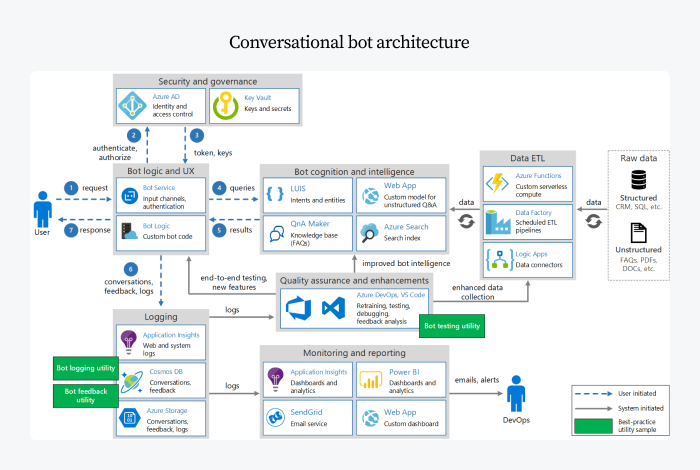
Some of the reasons you should consider using open-source solutions include:
- Less time-consuming
When you’re building your chatbots from the ground up, you require knowledge on a variety of topics. These include content management, analytics, graphic elements, message scheduling, and natural language processing. This will require you to spend a lot of time just to get the basics right. But you can reclaim that time by utilizing reusable components and connections for chatbot-related services.
Features that would have taken you days or weeks to develop require just a few clicks to implement into your website. And having access to the source code, you can always choose and manage components yourself.
- Efficient
If you decide to build your own bot without using any frameworks, you need to remember that the chatbot development ecosystem is still quite new. This means that there aren’t many guidelines or best practices. Everyone develops the bots according to a different architecture. It might be very challenging for you to start creating bots if you jump head-first into this task.
And even if you manage to build the bot efficiently and quickly, in most cases, it will have no graphical interface for quick edits. This will lead to developers having to administer the bot using text commands via the command line in each component. However, when you use a framework, the interface is available and ready for your non-technical staff the moment you install the chatbot.
- Cheaper
If you can code a chatbot yourself, then great! But if you need to hire a developer to do this for you, be prepared to pay a hefty amount for this job. An average salary of a chatbot developer ranges between $57,000 and $205,000 per year.
However, if you use a framework to build your chatbots, you can do it with minimal coding knowledge. And most of the open-source chatbot services are freely available and free to use. Not only that, it also opens up opportunities to leverage open source cloud cost optimization tools to help you optimize resource allocation, monitor usage patterns, and identify other cost-saving opportunities.
One more thing—
These were the advantages of using a bot framework instead of coding the chatbots from the ground up. But, you have another option out there. If you want to get bots on your website but don’t have much coding experience, you can use a chatbot platform. These usually provide a builder that doesn’t require any coding knowledge.
So, what are some of the pros and cons of using a chatbot framework instead of a platform?
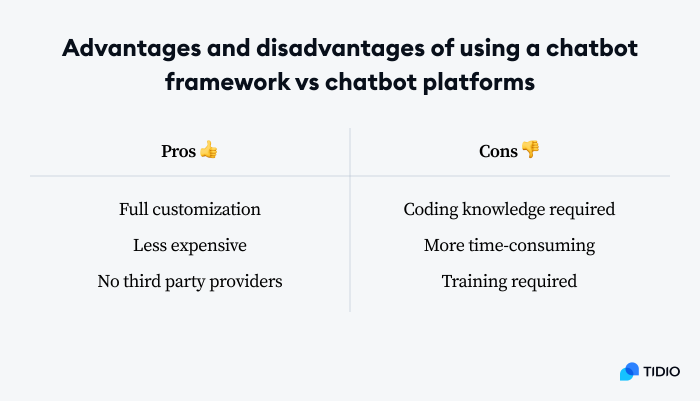
Now—
Before we move on to the best open-source chatbot frameworks, here’s a third party chatbot provider with a free forever plan, Tidio:
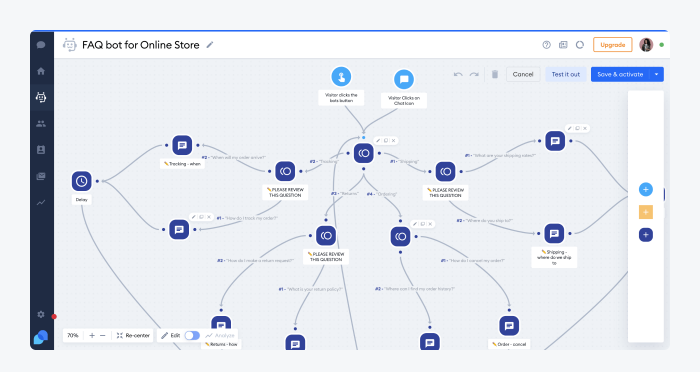
Tidio provides an open JavaScript API that gives you control over the widget’s behavior, messages, and bots with custom JavaScript code snippets. This makes it a good compromise between a regular “closed” platform SaaS solution and an “open” bot development framework, as it gives you more control. It could be used as your messaging “engine” but there are still many possibilities for customization.
On top of that, Tidio offers no-code free AI chatbots that you can customize with a visual chatbot builder. You can use the chatbot templates available and add custom pre-chat surveys to obtain visitors’ contact information. This will help you generate more leads and increase your customer databases. This software helps you grow your business and engage with visitors more efficiently.
But don’t just take our word for it—check out the reviews and take the software for a run free of charge.
Main features:
- Visual chatbot builder with a drag and drop editor
- 16 different triggers available
- Over 40 ready-to-use chatbot templates
- AI (artificial intelligence), NLP (natural language processing), and ML (machine learning) technologies available
- Variety of integrations (WordPress, Shopify, Facebook, Google Analytics)
- JavaScript API for controlling advanced bot behavior
- Free version available
- Starter ($29/mo)
- Flows ($29/mo)
- Lyro AI ($39/mo)
- Growth ($59/mo)
- Tidio+ (starts at $749/mo)
See live how easy it is to build and deploy chatbots
Read more: Learn how to get started with Tidio chatbots and get the most out of the software.
Now—
What are the top open-source chatbot frameworks you can use for your business?
Check out this comparison table for a quick side-by-side view of the best chatbot framework options.
| Framework | Ratings | Free plan | Best for |
|---|---|---|---|
| Microsoft bot framework | 4.3/5 ⭐️ | ✅ | Active learning |
| Wit.ai | 4/5 ⭐️ | ✅ | Powerful NLP engine |
| Rasa | 4.3/5 ⭐️ | ❌ | Contextual chatbots |
| DialogFlow | 4.4/5 ⭐️ | ❌ | IoT integration |
| BotPress | 4.4/5 ⭐️ | ✅ | Bot deployment on your own server |
| IBM Watson | 4.2/5 ⭐️ | ✅ | Strict security policies |
| Amazon Lex Framework | 3/5 ⭐️ | ❌ | Text into speech conversion |
| ChatterBot | n/a | ✅ | Language independent |
| BotKit | n/a | ✅ | Extensive documentation |
Okay—
Let’s have a look at the in-depth reviews of the 9 best open-source chatbots you can use for your business:
1. Microsoft bot framework
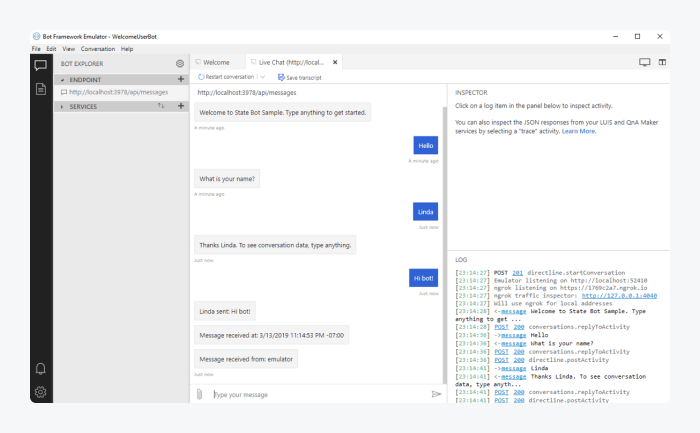
Ratings: 4.3/5 ⭐️ (2+ reviews)
This bot framework is also known as the Azure bot framework. It helps to build, publish, connect, and manage interactive chatbots. It includes active learning and multilanguage support to help you improve the communication with the user. It also uses the Azure Service platform, which is an integrated development environment to make building your bots faster and easier.
Microsoft chatbot framework provides pre-built models that you can use on your website, Skype, Slack, Facebook Messenger, Microsoft Teams, and many more channels. It’s aimed at developers because the approach is primarily code-driven. This open-source chatbot gives developers full control over the bot’s building experience and access to various functions and connectors.
Pros:
- Integrates with Microsoft Cognitive Services, Cortana, Kik, and many others
- SDKs for multiple computer languages available
- Speech-to-text machine learning
Cons:
- The NLU engine cannot be installed on-premise
- Standard channels (Free)
- Premium channels (10,000 message/month free, after: $0.50 per 1,000 messages)
When was Microsoft chatbot framework launched? Microsoft bot services were launched in March 2016.
2. Wit.ai
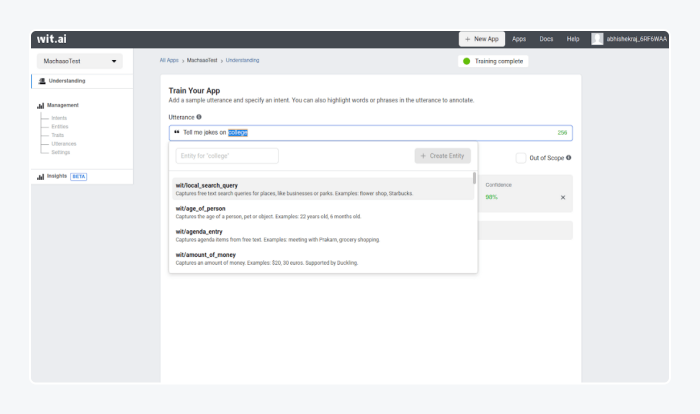
Ratings: 4/5 ⭐️ (1+ reviews)
Wit.ai was acquired by Facebook in 2015 which made deploying bots on Facebook Messenger seamless. It also offers integrations with other channels, including websites, mobile apps, wearable devices, and home automation. The SDK is available in multiple coding languages like Ruby, Node.js, and iOS.
This free chatbot framework provides a well-documented bot API so that even beginners can get started with this platform. It offers over 80 different languages and a strong NLP engine to create entities and intents. Some argue that it offers better NLP chatbots than the competitors, including Microsoft and Amazon. You can also use voice-based bots to make it more user-friendly.
Pros:
- Easy to deploy on Facebook Messenger
- Strong NLP engine
- SDK in multiple languages, including Python, Ruby, and Node.js
Cons:
- Laborious training
- Free to use
GitHub source code not available
Did you know that…
Our study on chatbot found that more than 70% of users have a positive experience when chatting with chatbots. What’s more, many consumers think companies should implement chatbots due to the 24/7 support and fast replies.
3. Rasa
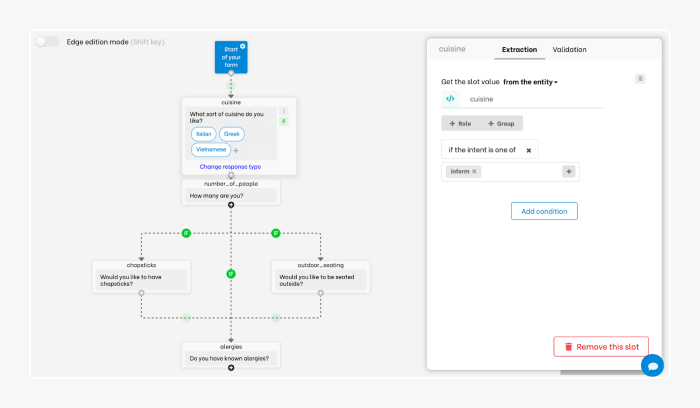
Ratings: 4.3/5 ⭐️ (5+ reviews)
This open source framework works best for building contextual chatbots that can add a more human feeling to the interactions. You can build stories to train your bots. These stories will act as expected conversational flows. And, the system supports synonyms and hyponyms, so you don’t have to train the bots for every possible variation of the word. After deploying the virtual assistants, they interactively learn as they communicate with users.
This chatbot framework consists of two major components. These are Rasa NLU (natural language understanding) and Rasa Core for creating conversational chatbots. Combined, these components help users in building bots that are capable of handling complex user inquiries. You can store data in customer databases to grow your understanding of your clients.
Pros:
- Multiple environments for development, staging, and production
- Analytics for customer data
- Highly customizable when it comes to features and design
Cons:
- Not suitable for beginners as it requires you to have an understanding of NLP, deep learning, and know Python language to build contextual chatbots
- Contact sales for custom pricing
Read more: Check out the best open source helpdesk software on the web.
4. DialogFlow
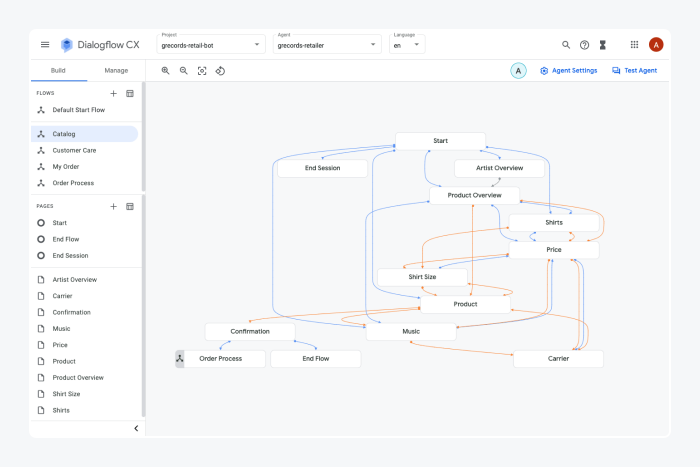
Ratings: 4.4/5 ⭐️ (20+ reviews)
DialogFlow lets you build text or voice-based conversational interfaces or conversational chatbot interfaces. It’s powered by Google’s machine learning, and it enables you to connect to users on Google Assistant, Amazon Alexa, Facebook Messenger, mobile apps, and many other channels.
This Google bot framework is user-friendly and ready to scale. It uses Node.js SDK for the fulfillment, and you can use PHP, Java, Ruby, Python, or C# for intent detection and agent API. You can also provide chatbots for home automation with the IoT (Internet of Things) integration. It offers more than 20 languages worldwide and SDKs for more than 14 different platforms.
Pros:
- Supports text-based and voice-based assistants
- Sentiment analysis on queries
- IoT integration allowed
Cons:
- No live customer support
- Trial period (new customers receive a $600 credit for no charge)
- Text ($0.007/request)
- Audio input/output ($0.06 per minute)
GitHub source code not available
5. BotPress
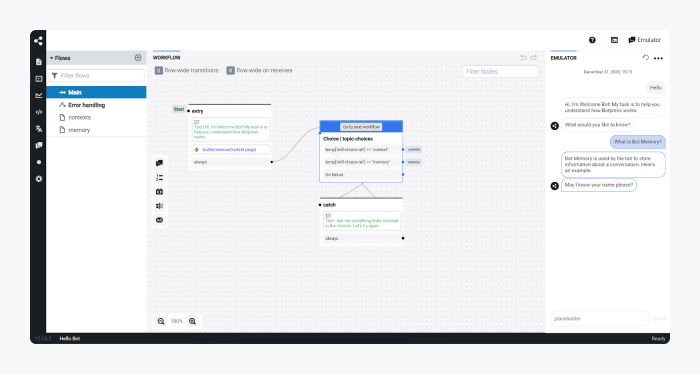
Ratings: 4.4/5 ⭐️ (20+ reviews)
This is one of the best open-source chatbot frameworks that offer modular architecture, so you can build chatbots in modules that can work independently of each other. BotPress allows you to create bots and deploy them on your own server or a preferred cloud host. It also provides a visual conversation builder and an emulator to test conversations. This can help you create more natural and human-like interactions with clients.
This open-source platform gives you actionable chatbot analytics, so you can keep an eye on your results and make better business decisions. It lets you define intents, entities, and slots with the help of NLU modules. You can also use advanced permissions to control who gets to edit the bot. Also, it offers spell checking and language identification for better customer communication.
Pros:
- Visual conversation builder
- Advanced permissions
- Easy-to-understand documentation
Cons:
- Limited features with mainly rule and action based bots available
- Free open-source version
- Enterprise plan → contact sales for custom pricing
Did you know that…
About 90% of companies that implemented chatbots record large improvements in the speed of resolving complaints.
6. IBM Watson
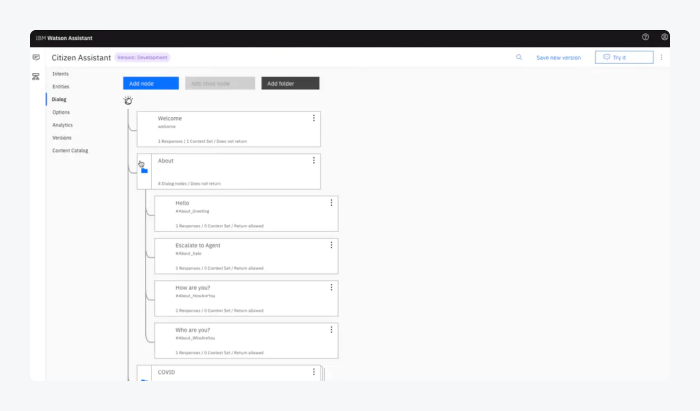
Ratings: 4.2/5 ⭐️ (490+ reviews)
IBM Watson bots were trained using data, such as over a billion Wikipedia words, and adapted to communicate with users. It responds to natural language input using machine learning. This open-source chatbot works on mobile devices, websites, messaging apps (for iOS and Android), and robots. You can classify text into custom categories from multiple languages.
This bot framework offers great privacy and security measures for your chatbots, including visual recognition security. It isolates the gathered information in a private cloud to secure the user data and insights. It also provides a variety of bot-building toolkits and advanced cognitive capabilities. You can use predictive analytics to make better-informed business decisions in the future.
Pros:
- Strict privacy policies
- Advanced machine learning engine
- Visual recognition security
Cons:
- Difficult to use framework
- Free Lite plan
- Plus ($140/month)
- Enterprise → contact sales for custom pricing
GitHub source code not available
7. Amazon Lex Framework
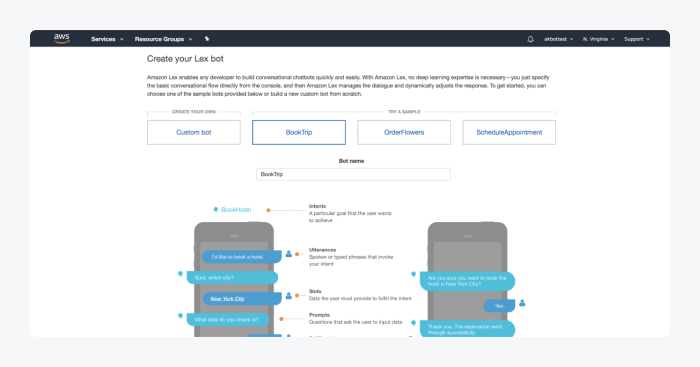
Ratings: 3/5 ⭐️ (1+ reviews)
This open-source chatbot is offered by Amazon Web Services (AWS) and it uses the Amazon AI suite. It can convert audio into text as well as convert text to human speech. It supports various social media and messaging platforms, including Facebook Messenger, Kik, and Twilio SMS on which you can deploy your bots through a one-click process.
Amazon Lex Framework offers automatic scaling capabilities that decrease the need for developers to increase the bot’s capabilities by managing the infrastructure and hardware. It offers an easy-to-use AI chatbot framework for beginners to start creating their own chatbots. These open-source bots have built-in machine learning, NLP, and allow for automated speech recognition.
Pros:
- Automated speech recognition
- Various integrations, including Slack, Kik, Facebook Messenger, and more
- Converts audio into text and text into speech
Cons:
- Not multilingual, only English available
- Text requests ($0.00075/request)
- Speech requests ($0.004/request)
GitHub source code not available
8. ChatterBot
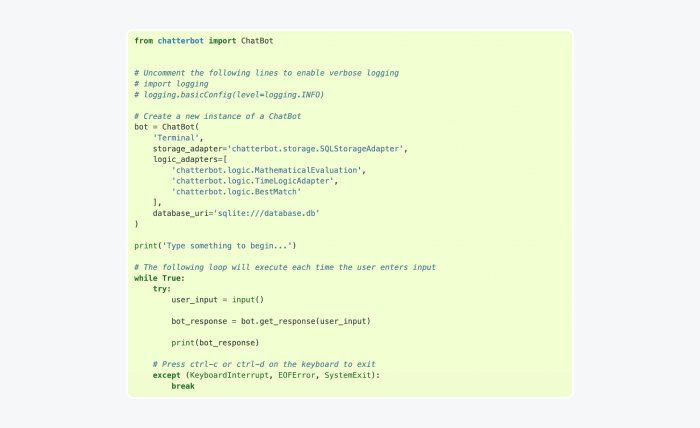
Ratings: N/A
ChatterBot is a Python-based bot flow that is automated through machine learning technology. It’s a chatbot Python library that can be imported and used in your Python projects. Its working mechanism is based on the process that the more input ChatterBot receives, the more efficient and accurate the output will be.
This Python chatbot offers marketing automation and answer features. It also integrates with Facebook and Zapier for additional functionalities of your system. You can easily customize and edit the code for the chatbot to match your business needs. On top of that, it has a language independence nature that enables training it for any language.
Pros:
- Language independent
- Works across all devices
- Efficiency improves with input
Cons:
- Requires advanced Python programming skills
Pricing:
- Free to use
Did you know that…
Global chatbot market is predicted to reach $2,166 million by 2024 which is a Compound annual growth rate of nearly 29% between 2018 and 2024.
9. BotKit
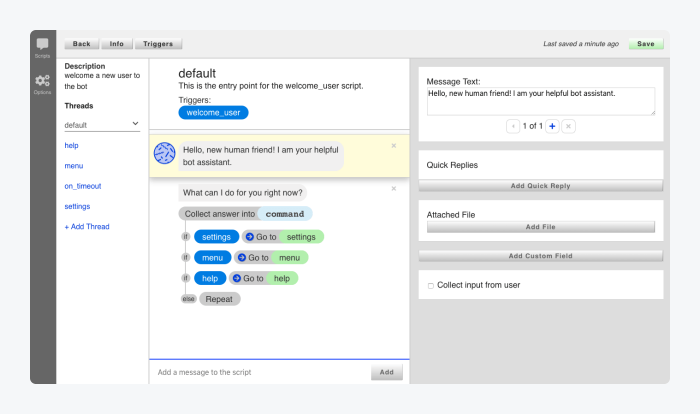
Ratings: N/A
This open-source conversational AI was acquired by Microsoft in 2018. Some of its built-in developer tools include content management, analytics, and operational mechanisms. You can learn how your visitors use the bots and who the users are. It offers extensive documentation and a great community you can consult if you have any issues while using the framework.
BotKit is a code-centric platform with a visual conversational builder and many integrations for your needs. These include Cisco Spark, Google Hangouts, Microsoft Teams, and more. It also provides a flexible system for handling transactional questions and scripted dialogs. You can use the meaningful building blocks for creating conversational user interfaces and provide a great customer experience for your visitors.
Pros:
- Easy-to-use interface
- Visual conversation builder
- Supports all major platforms
Cons:
- No built-in NLP—uses Microsoft’s LUIS service
Pricing:
- Free to use
Read more: Discover the real-life chatbot use cases that work.
So, what to look out for to pick the right option for your company?
Let’s find out.
How to choose the right open-source chatbot for your business?
Since you already saw what are the best chatbot open-source frameworks out there, it’s time to determine what you should look out for to find the best match for your business. Each company is different and, naturally, they all have specific needs and requirements.
Starting from documentation and included features, ending on the price and community. Here are the five things you should consider when choosing an open-source bot framework:
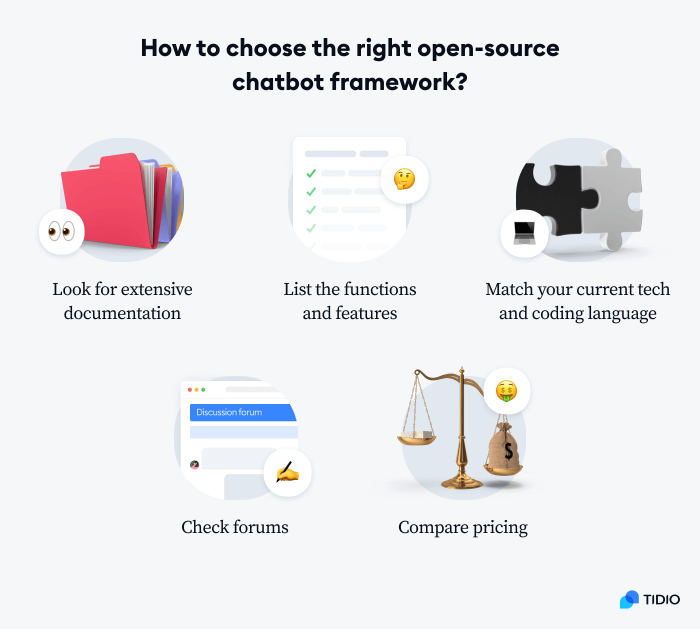
- Look for extensive documentation
Good documentation will help you get started with the chatbot software. You should be able to find how to download it, use it, and check the updates that were made to the code. This is important for the development process and for you to know whether the software is kept up to date.
- List the desired functionalities and features
Think about what functions do you want the chatbot to perform and what features are important to your company. While looking at your options for a chatbot workflow framework, check if the software offers these features or if you can add the code for them yourself.
- Match your technology and coding language
What technology and coding language are you currently using? Your chatbot needs to fit it and work well along with it. Checking how other companies use chatbots can also help you decide on what will be the best for your business.
- Check forums
Fellow developers are your greatest help, especially when you’re starting to use a bot framework. Someone out there probably had the same problem you’re facing at the moment, and they found a solution. Forums are the places you can easily find these solutions and discussions about different possibilities.
- Compare pricing
Open-source chatbots are free. However, some solutions will require you to use them to host your chatbots on their servers. This way, you’ll have to pay for each text and media input you have during your customer communication. So, look for software that is free forever or chatbot pricing that matches your budget.
Summary
That’s all for now, but let’s do a quick recap of the things we discussed today.
Chatbot frameworks are the place where you can develop your bots with a preset bot structure. They differ from chatbot platforms because they require you to have some coding knowledge while also giving you complete control over the finished bots. And open-source chatbots are software with a freely available and modifiable source code.
The best open-source chatbot frameworks include:
- Microsoft bot framework
- Wit.ai
- Rasa
- DialogFlow
- BotPress
- IBM Watson
- Amazon Lex Framework
- ChatterBot
- BotKit
Remember to look for extensive documentation, check available forums, and see which of the desired features the framework you’re looking at has. Also, check what you’ll have to code in yourself and see if the pricing matches your budget.
One more thing—always compare a few options before deciding on the bot framework to use. You’ll have to put in some work to make it perfect for your business, and it would be a shame to have to change the software in the middle of your progress.
While chatbot frameworks are a great way to build your bots quicker, just remember that you can speed up the process even further by using a chatbot platform.
Create free chatbots to increase sales and improve customer service
